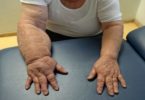What's in this article?
What is Broken Collarbone
A broken collarbone is a common injury, particularly in children and young adults. Your collarbone connects the upper part of your breastbone to your shoulder blade. Common causes of a broken collarbone include falls, sports injuries and trauma from traffic accidents. Infants can sometimes experience a broken collarbone during the birth process.
If you think you or your child has a broken collarbone, seek prompt medical attention. Most broken collarbones heal well with ice, pain relievers, a sling, physical therapy and time. But a complicated broken collarbone may require surgery to realign the broken bone and to implant plates, screws or rods into the bone to maintain proper alignment during healing.
What Does a Broken Collarbone Feel Like?
A broken collarbone is usually pretty obvious. You might feel a crack when it happens. Afterward, you will probably have:
- Pain and swelling
- Difficulty moving your arm and shoulder
- A grinding feeling when you try to raise your arm
- Sagging in your shoulder
- A bump around the area of the break
To diagnose a broken collarbone, your doctor will give you a thorough physical exam. You will need X-rays to confirm the break.
Broken Collarbone Causes
Some people can break their clavicle without any trauma. These people usually have weak bone structure either from a genetic cause (they were born with it) or from an acquired cause (such as osteoporosis or cancer).
Newborns
- Occasionally during delivery of an otherwise healthy baby, the forces involved in trying to deliver the baby from the mother can break the collarbone. This is the most common bone broken during delivery. This is usually detected in the hospital, and the baby recovers well.
- Even more rarely, a physician may have to break the infant’s collarbone in order to deliver the baby safely. This only occurs when a process known as shoulder dystocia develops. There are many other techniques available to overcome this, so it is rarely practiced today.
Children and adolescents
- The collarbone is the most commonly broken bone in childhood. These breaks are usually the result of falling directly on the shoulder or on an outstretched arm during play or sports. They can occasionally be the result of a direct blow to the collarbone, such as during tackling in football (without pads), or being crosschecked during hockey or lacrosse.
Broken Collarbone Symptoms
- Signs and symptoms of a broken collarbone include:
- Pain that increases with shoulder movement
- Swelling
- Tenderness
- Bruising
- A bulge on or near your shoulder
- A grinding or crackling sound when you try to move your shoulder
- Stiffness or inability to move your shoulder
Treatment for a Broken Collarbone?
Usually, a broken collarbone will heal on its own. You just need to give it time.
To help speed the healing, you might need:
- A splint or brace to keep your shoulder from moving
- A sling for your arm, which you might use for a few days
- Anti-inflammatory painkillers, like ibuprofen, naproxen, or aspirin which will help with pain and swelling. However, these drugs have side effects, like an increased risk of bleeding and ulcers. They should be used only occasionally unless your doctor specifically says otherwise as they may delay bone healing.
- Range-of-motion and strengthening exercises
In rare cases especially when ligaments are damaged you may need surgery to mend a collarbone fracture.
Broken Collarbone Diagnosis
The doctor will take a brief history to determine how the injury occurred. If necessary, a thorough physical exam will be conducted to evaluate for any other injuries.
- Specifically, the shoulder will be touched and inspected to identify signs of a broken collarbone. The nerves in the arm will be tested to make sure no injury has occurred there. Also, the doctor will listen to the lungs to make sure they were not injured by the broken collar bone.
- An X-ray of the clavicle is usually ordered to determine what type of break occurred. Sometimes, the break can be very difficult to see on X-ray, and several views of the shoulder may be needed. The doctor usually can show the patient the fracture on the X-ray.
- In rare cases a CT scan needs to be performed to find the fracture.
Recently ultrasound has been used in children to diagnose clavicle fractures.





